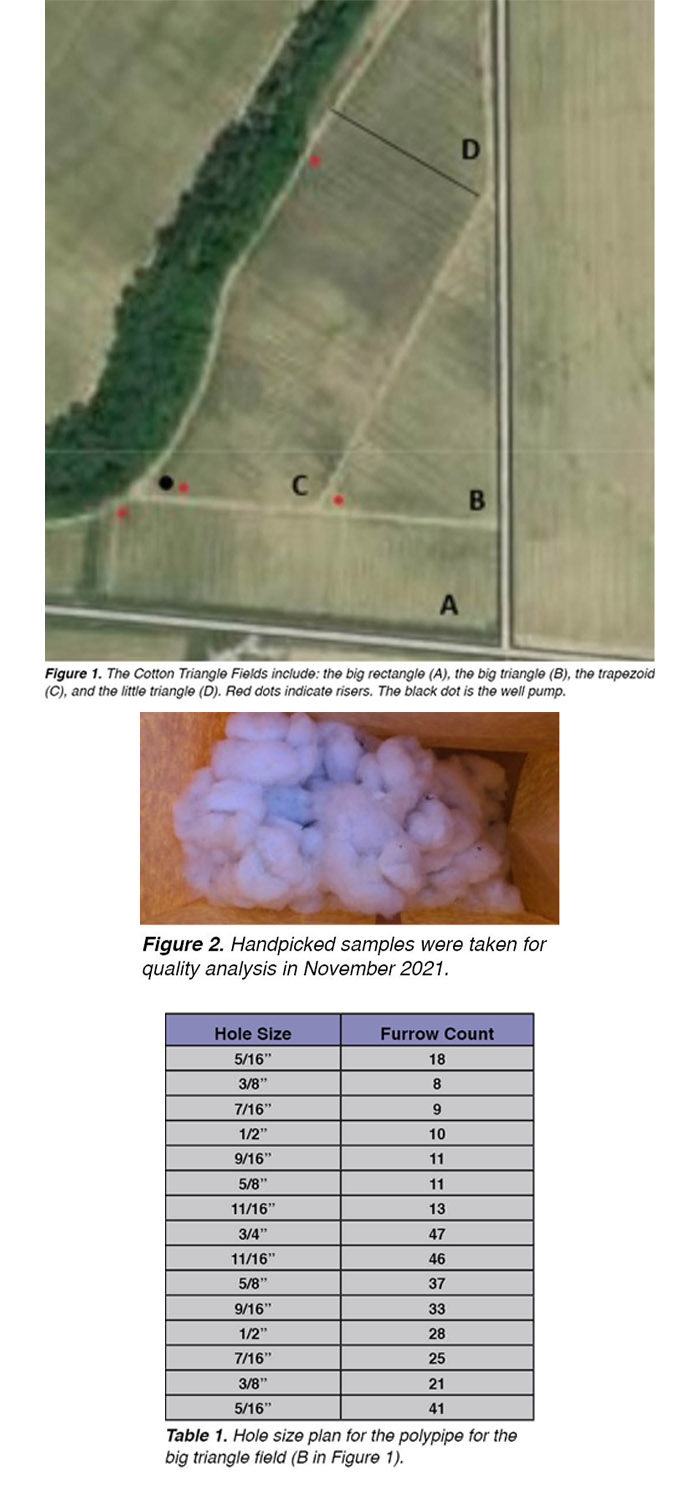Research Project
Examining the Efficacy of Variable Hole Sizing in Polypipe for the Irrigation of Irregularly Shaped Cotton Fields
Investigators: Amanda Nelson, Daryl Chastain
Date: 2021
Project Summary
Introduction
Programs such as the Delta Plastics Pipe Planner program were designed to create efficient irrigation plans for various fields utilizing variable hole sizes in polypipe irrigation. The objective of this study is to determine the effectiveness of these programs on water use and cotton yield from regularly and irregularly shaped fields.
Materials and Methods
The site consists of four fields located in Washington County, Mississippi (33.429777°, 90.948461°), at the corner of Old Leland Road and Potter Road (Figure 1) at the NCAAR West Farm facility. Fields were planted with Deltapine 1646 cottonseed at 40” row spacing. Each length of polypipe had its own flow meter to measure independently the volume of irrigation water applied on each field. The big rectangle and big triangle (A and B in Figure 1) were irrigated according to the plan determined by the Delta Plastics Pipe Planner program. The trapezoid and little triangle (C and D in Figure 1) were irrigated under a “business as usual” plan to represent a plan that a farmer without computerized hole selection might use to irrigate similar fields in the Delta. The trapezoid and little triangle (C and D in Figure 1) utilized two risers. The polypipe from the southern riser irrigated only the trapezoid and was tied off at the boundary between these two fields. The polypipe from the northern riser irrigated only the little triangle. Altogether from south to north, the hole sizes were 3/8” for 135 furrows, then 7/16” until the field started to taper again (~280 furrows), and finally back to 3/8” for the remainder. The big rectangle (A in Figure 1) used two hole sizes, per the Pipe Planner output: 1/2” for 165 furrows and 9/16” for the remaining ~230 furrows. The triangle (B in Figure 1) used the hole size plan in Table 1. Every 7-10 days after the previous significant rainfall or irrigation, water was applied until all furrows were wet.
Results/Current Status
2021 had a very wet spring. As a result, the cotton did not get planted until late June. In addition, it was a wet growing season and, as such, irrigation was not required according to the standards we set. Handpicked samples for quality were taken in November, but harvesting did not occur until January 2022. Since no irrigation was used and the timing of management events were irregular, the 2021 season will be used as a baseline year to determine that there are no factors among the fields affecting cotton yield quantity and quality going forward. This project will be repeated in the 2022 season.
Project Photos

- Crop Type:
- Cotton
- Topic:
- Irrigation Schedule
- Irrigation
Find Research
By Crop Type
By Topic
Contact NCAAR
General Information
Kaye Sullivan
vfs23@msstate.edu
662.390.8510
F:662.390.8501
Showcase Demo
Drew Gholson, Coordinator
drew.gholson@msstate.edu
662.390.8505
Himmy Lo
himmy.lo@msstate.edu
662.390.8509

